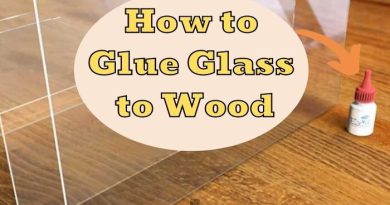How to Dry Wood in a Microwave Oven [In 8 Easy Steps]
Drying the wood before you begin your carpentry project is important if you don’t want your finished product to twist, crack or warp upon delivery. Now let’s talk about how to dry wood in the microwave oven. It is clear that this method is suitable for drying small-sized wood.
Unfortunately, drying wood using a natural method takes time. For example the natural method of air drying usually takes approximately a year to dry wood per inch of thickness, and you don’t have much time to wait that long.
Fortunately, there is a quick way to dry your wood if you are only working on small pieces of wood and this is through the use of a microwave oven.
How to Dry Wood in a Microwave Oven Step by Step
Yes, it is possible to dry any type of wood in a microwave oven. You can do this as long as the wood is small enough to fit.
In this article, you will learn how to dry wood in a microwave oven in 5 steps:
What you will need:
- Microwave oven
- Digital scale
- Moisture meter
- Paper towels
- Oven mitts
Step 1: Choose a microwave for drying
A cheap and low-power microwave with a rotating table without unnecessary electronic “bells and whistles” is best suited. In this case, it is important that the stove has the ability to set the minimum power. For models without digital display, this function corresponds to the “defrost” mode.
In addition, you need to pay attention to the dimensions of the microwave chamber and the door – so that the woods are placed in the oven. When buying, be sure to keep in mind that often the depth of the microwave chamber is less than its width.
You will also need a scale with a scale division of 5 g or so. Household ones with an arrow are fine, but digital ones with an indicator, of course, are more convenient.
Drying wood in the microwave in the form of a finished product is not recommended – as a rule, wood does not crack during the drying process. But no one is immune from cracking of the ends, and if you gape during the operation of the microwave oven, the wood can smoke, become charred.
Such troubles are unlikely, but while you are only an experimenter, practice what is not a pity. Alternatively, give the wood the desired shape with an allowance of 10-15 cm, so that later, without regret, remove the excess.
Make sure that the selected bar can safely enter and rotate in the microwave. In standard microwave ovens, the diameter of the table is 25 cm.
Step 2: Measure the weight of the wood before drying
Using a mailing scale, weigh your wood samples to determine how much moisture to lose. Place your wood on the postal scale and measure it in grams.
For best results, choose balances with an accuracy of 0.1%.
Step 3: Determine the moisture content
Using a moisture meter, measure the moisture content of each piece of wood. Take note of the moisture content, which will be a percentage between 0 and 100. This will be used later to calculate the moisture content after final heating.
Here is a step by step guide to help you remove mold from wood in a few east steps!
Step 4: Start to dry the wood using the microwave
We put the bar that needs to be dried in the microwave. In the “defrost” mode, we heat it for a minute (the time can be increased, but better start with a minute, then you will understand. In general, the larger the diameter of the workpiece, the longer you can put it).
Set the microwave oven to its lowest setting. This can be “Low” or “Defrost” in your microwave oven settings. Place three to five paper towels under the wood to absorb the moisture it would produce. Heat the wood for up to 1 minute.
At this point, you should lose about 15% to 25% of the moisture content of each piece of wood.
We set the dry time in accordance with the size of the wood:
| Dry time according to the size of the wood |
| 1. Wood with size less than 20 cm : 1 minute |
| 2. Wood with 20 -30 cm size: 2 minutes |
| 3. Wood with size larger than 30 cm: 3 minutes |
Step 5: Remove the wood from the microwave oven and check the drying state
After 1 minute, take out the wood piece from the oven using your mittens, wrap the wood in a newspaper and a plastic bag with a hole. This should be done so that with strong evaporation, provoked by the heating of water molecules inside the wood, the wood does not crack. If you dry coniferous wood in the microwave, then it is better to put it wrapped in a block and in the oven: it is possible that the resin will not boil in the product (especially the resin pocket ).
Remember that when drying, an object carved from wood may deform, for example, round – become oval. When working with wood of your choice, you will quickly learn how much it deforms when dried and reduce the stock. Keep in mind that the wood can burst easily if you leave the raw, processed piece just on the table. Therefore, during breaks in carving or before microwave drying, store the craft in a plastic bag.
It is better to wrap the wood block in newspapers, and only then put them in a bag. However, this approach reduces the risk of cracking and conventional workpieces. Newspapers should be changed after cooling down, before the next heating cycle in the oven.
If there are resin pockets in the wood, they can boil and tear it apart, and sprinkle resin on the stove. Therefore, when drying resinous woods, it is also worth wrapping the workpiece in paper.
We wait half an hour for the wood to cool down, unfold. The newspaper will become wet and there will be drops of condensation on the bag. So everything is going right.
Step 6: Weigh the wood after the first drying cycle
Measure and record the weight of the wood after the first drying cycle. The drop in weight means that the moisture is going away.
We weigh the wood, remember or write down the weight and dry it again for a minute, take it out, wrap it in a dry newspaper and a bag.
Step 7: Continue to dry the wood in the microwave oven
Continue to heat the wood until the moisture content is stable. For subsequent turns, heat the pieces of wood for 45 to 60 seconds. Take a minute’s rest between each round.
Do this until you reach the goal: no more weight change in the wood after heating. If you can no longer detect a variation of more than 0.1 gram using a very precise scale, then you have reached your goal.
During the last cycles of drying wood in the microwave, little moisture evaporates, so you can do without wrapping. There can be any number of cycles – from two to three to twenty.
It all depends on the initial moisture content of the wood, its species and your personal understanding of the concept of “dry wood” (if a moisture meter is not available). If the plate does not turn around in your microwave, turn the position of the workpiece 90 degrees with each cycle, so it will dry up evenly.
Step 8: Verify the dry wood in the microwave
After all the cycles of drying the wood in the microwave have passed and the wood has cooled down, when tapping, you can hear a characteristic sonorous sound – the wood is dry. Another plus of drying wood in the microwave is that it will not crack or warp over time. Do-it-yourself wood drying will give you a material that is easy to process.
Thus, drying wood in the microwave oven is another way to quickly dry wood with your own hands at home. Perhaps this method will seem boring to someone (weigh – wrap-cool-dry ), but when the workpiece needs to be dried quickly and at home, then drying the wood in the microwave can help.
Calculate the moisture content after final heating using the following formula: (Wet Weight – Weight when oven dried / Weight after drying) x 100.
Tips and advices for drying wood in the microwave oven
- If you dry the finished product, be prepared for the fact that it may change its shape during the drying process. Therefore, before drying the product, practice on small samples of wood to know how much it deforms.
- Whenever possible, dry only the rough stock that can be reworked after the final process.
- Store the finished craft or workpiece in a plastic bag between work or during the cooling process.
- If condensed water appears in the bag during drying, it must be poured out before re-placing it in the oven.
- The optimal drying mode and the number of cycles required are determined empirically, so write down all the results in a special notebook.
- When drying resinous wood blanks, wrapping it in newspaper is a prerequisite. The boiling resin can break the workpiece, and besides, it also splashes the oven chamber. Newspapers should be replaced with new ones after each drying cycle.
- A banal, but very important rule – learn from inexpensive products and blanks, then the chances of successful drying without deformation of products will be higher. You will prevent overheating and charring of the workpiece, as well as its cracking.
In fact, the microwave drying process is not that complicated. Punctually and consistently performing these simple steps, you will certainly achieve success. High-quality dried material for the craft is a guarantee that the time spent on making the craft will not be wasted.
How to test if your wood is dry?
There are several methods you can use to test that your wood is dry enough to heat with:
- The detergent test
- The impact test, which gives a quick indication of whether the wood is dry enough
- The eye test. Dirt, mold, and fungus are indicators of moisture.
- The moisture test using a moisture meter. Find out the exact moisture content of your wood.
Conclusion
In eight easy steps, you can quickly dry small pieces of wood using a microwave. No need to wait long to start your woodworking project.
Now that you’ve learned how to dry wood in the microwave oven, you can already work on your next wood craft without the risk of twisting, cracking, or warping your finished product.
How to calculate the water content of the wood?
The exact conversion is carried out using the following formula:
Wood Water content = (Wood moisture / (100 + Wood moisture)) x 100, where
Wood moisture = (Water content / (100 Water content)) x 100
How to dry wood in microwave without cracking?
The cracks in the wood are caused by drying too quickly so when drying wood, wrapping it in newspaper is a necessary.
There are many tips to avoid wood cracks, but these often depend on the type of wood. Basically, however: end grain surfaces should always be covered.
Is it safe to dry wood in the microwave?
Yes, it is safe to dry wood in the microwave as long as you pay attention to the dry time which should not exceed 2 minutes. The dry of wood in the microwave should be done in multiple rounds/cycles, each cycle should not exceed 2 minutes.



